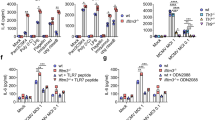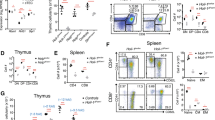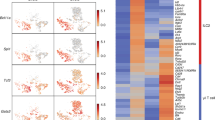Abstract
Thymic output is a dynamic process, with high activity at birth punctuated by transient periods of involution during infection. Interferon-α (IFN-α) is a critical molecular mediator of pathogen-induced thymic involution, yet despite the importance of thymic involution, relatively little is known about the molecular integrators that establish sensitivity. Here we found that the microRNA network dependent on the endoribonuclease Dicer, and specifically microRNA miR-29a, was critical for diminishing the sensitivity of the thymic epithelium to simulated infection signals, protecting the thymus against inappropriate involution. In the absence of Dicer or the miR-29a cluster in the thymic epithelium, expression of the IFN-α receptor by the thymic epithelium was higher, which allowed suboptimal signals to trigger rapid loss of thymic cellularity.
This is a preview of subscription content, access via your institution
Access options
Subscribe to this journal
Receive 12 print issues and online access
$209.00 per year
only $17.42 per issue
Buy this article
- Purchase on SpringerLink
- Instant access to full article PDF
Prices may be subject to local taxes which are calculated during checkout







Similar content being viewed by others
References
Miller, J.F. Immunological function of the thymus. Lancet 2, 748–749 (1961).
Itoh, M. et al. Thymus and autoimmunity: production of CD25+CD4+ naturally anergic and suppressive T cells as a key function of the thymus in maintaining immunologic self-tolerance. J. Immunol. 162, 5317–5326 (1999).
King, C.C. et al. Viral infection of the thymus. J. Virol. 66, 3155–3160 (1992).
Anz, D. et al. Activation of melanoma differentiation-associated gene 5 causes rapid involution of the thymus. J. Immunol. 182, 6044–6050 (2009).
Aronson, M. Hypothesis: involution of the thymus with aging–programmed and beneficial. Thymus 18, 7–13 (1991).
Dowling, M.R. & Hodgkin, P.D. Why does the thymus involute? A selection-based hypothesis. Trends Immunol. 30, 295–300 (2009).
Fu, Y., Paul, R.D., Wang, Y. & Lopez, D.M. Thymic involution and thymocyte phenotypic alterations induced by murine mammary adenocarcinomas. J. Immunol. 143, 4300–4307 (1989).
Olsen, N.J., Olson, G., Viselli, S.M., Gu, X. & Kovacs, W.J. Androgen receptors in thymic epithelium modulate thymus size and thymocyte development. Endocrinology 142, 1278–1283 (2001).
Sutherland, J.S. et al. Activation of thymic regeneration in mice and humans following androgen blockade. J. Immunol. 175, 2741–2753 (2005).
Domínguez-Gerpe, L. & Rey-Mendez, M. Time-course of the murine lymphoid tissue involution during and following stressor exposure. Life Sci. 61, 1019–1027 (1997).
Sasaki, S., Ishida, Y., Nishio, N., Ito, S. & Isobe, K. Thymic involution correlates with severe ulcerative colitis induced by oral administration of dextran sulphate sodium in C57BL/6 mice but not in BALB/c mice. Inflammation 31, 319–328 (2008).
Rodriguez, A. et al. Requirement of bic/microRNA-155 for normal immune function. Science 316, 608–611 (2007).
Martinez-Nunez, R.T., Louafi, F., Friedmann, P.S. & Sanchez-Elsner, T. MicroRNA-155 modulates the pathogen binding ability of dendritic cells (DCs) by down-regulation of DC-specific intercellular adhesion molecule-3 grabbing non-integrin (DC-SIGN). J. Biol. Chem. 284, 16334–16342 (2009).
Taganov, K.D., Boldin, M.P., Chang, K.J. & Baltimore, D. NF-κB-dependent induction of microRNA miR-146, an inhibitor targeted to signaling proteins of innate immune responses. Proc. Natl. Acad. Sci. USA 103, 12481–12486 (2006).
Liu, G. et al. miR-147, a microRNA that is induced upon Toll-like receptor stimulation, regulates murine macrophage inflammatory responses. Proc. Natl. Acad. Sci. USA 106, 15819–15824 (2009).
Sheedy, F.J. et al. Negative regulation of TLR4 via targeting of the proinflammatory tumor suppressor PDCD4 by the microRNA miR-21. Nat. Immunol. 11, 141–147 (2010).
Androulidaki, A. et al. The kinase Akt1 controls macrophage response to lipopolysaccharide by regulating microRNAs. Immunity 31, 220–231 (2009).
Liston, A., Linterman, M. & Lu, L.F. MicroRNA in the adaptive immune system, in sickness and in health. J. Clin. Immunol. 30, 339–346 (2010).
Hou, J. et al. MicroRNA-146a feedback inhibits RIG-I-dependent Type I IFN production in macrophages by targeting TRAF6, IRAK1, and IRAK2. J. Immunol. 183, 2150–2158 (2009).
Liston, A. et al. Lack of Foxp3 function and expression in the thymic epithelium. J. Exp. Med. 204, 475–480 (2007).
Yi, R. et al. Morphogenesis in skin is governed by discrete sets of differentially expressed microRNAs. Nat. Genet. 38, 356–362 (2006).
Betel, D., Wilson, M., Gabow, A., Marks, D.S. & Sander, C. The microRNA.org resource: targets and expression. Nucleic Acids Res. 36, D149–D153 (2008).
Hwang, H.W., Wentzel, E.A. & Mendell, J.T. A hexanucleotide element directs microRNA nuclear import. Science 315, 97–100 (2007).
Sheehan, K.C.F. et al. Blocking monoclonal antibodies specific for mouse IFN-α/β receptor subunit 1 (IFNAR-1) from mice immunized by in vivo hydrodynamic transfection. J. Interferon Cytokine Res. 26, 804–819 (2006).
Muljo, S.A. et al. Aberrant T cell differentiation in the absence of Dicer. J. Exp. Med. 202, 261–269 (2005).
Cobb, B.S. et al. T cell lineage choice and differentiation in the absence of the RNase III enzyme Dicer. J. Exp. Med. 201, 1367–1373 (2005).
Koralov, S.B. et al. Dicer ablation affects antibody diversity and cell survival in the B lymphocyte lineage. Cell 132, 860–874 (2008).
Kuipers, H., Schnorfeil, F.M., Fehling, H.J., Bartels, H. & Brocker, T. Dicer-dependent microRNAs control maturation, function, and maintenance of Langerhans cells in vivo. J. Immunol. 185, 400–409 (2010).
Liston, A., Lu, L.F., O'Carroll, D., Tarakhovsky, A. & Rudensky, A.Y. Dicer-dependent microRNA pathway safeguards regulatory T cell function. J. Exp. Med. 205, 1993–2004 (2008).
Rodewald, H.R., Paul, S., Haller, C., Bluethmann, H. & Blum, C. Thymus medulla consisting of epithelial islets each derived from a single progenitor. Nature 414, 763–768 (2001).
Sato, T. et al. Surface molecules essential for positive selection are retained but interfered in thymic epithelial cells after monolayer culture. Cell. Immunol. 211, 71–79 (2001).
Flomerfelt, F.A., Kim, M.G. & Schwartz, R.H. Spatial, a gene expressed in thymic stromal cells, depends on three-dimensional thymus organization for its expression. Genes Immun. 1, 391–401 (2000).
Fukagawa, T. et al. Dicer is essential for formation of the heterochromatin structure in vertebrate cells. Nat. Cell Biol. 6, 784–791 (2004).
Anderson, G., Pongracz, J., Parnell, S. & Jenkinson, E.J. Notch ligand-bearing thymic epithelial cells initiate and sustain Notch signaling in thymocytes independently of T cell receptor signaling. Eur. J. Immunol. 31, 3349–3354 (2001).
Wilson, A., MacDonald, H.R. & Radtke, F. Notch 1-deficient common lymphoid precursors adopt a B cell fate in the thymus. J. Exp. Med. 194, 1003–1012 (2001).
Bix, M. & Raulet, D. Inefficient positive selection of T cells directed by haematopoietic cells. Nature 359, 330–333 (1992).
Lu, L.F. & Liston, A. MicroRNA in the immune system, microRNA as an immune system. Immunology 127, 291–298 (2009).
Fedeli, M. et al. Dicer-dependent microRNA pathway controls invariant NKT cell development. J. Immunol. 183, 2506–2512 (2009).
Lynn, F.C. et al. MicroRNA expression is required for pancreatic islet cell genesis in the mouse. Diabetes 56, 2938–2945 (2007).
Wiesen, J.L. & Tomasi, T.B. Dicer is regulated by cellular stresses and interferons. Mol. Immunol. 46, 1222–1228 (2009).
Gordon, J. et al. Specific expression of lacZ and cre recombinase in fetal thymic epithelial cells by multiplex gene targeting at the Foxn1 locus. BMC Dev. Biol. 7, 69 (2007).
Geboes, L. et al. Proinflammatory role of the Th17 cytokine interleukin-22 in collagen-induced arthritis in C57BL/6 mice. Arthritis Rheum. 60, 390–395 (2009).
Kelchtermans, H. et al. Defective CD4+CD25+ regulatory T cell functioning in collagen-induced arthritis: an important factor in pathogenesis, counter-regulated by endogenous IFN-gamma. Arthritis Res. Ther. 7, R402–R415 (2005).
Dooley, J., Erickson, M. & Farr, A.G. Alterations of the medullary epithelial compartment in the Aire-deficient thymus: implications for programs of thymic epithelial differentiation. J. Immunol. 181, 5225–5232 (2008).
Silahtaroglu, A.N. et al. Detection of microRNAs in frozen tissue sections by fluorescence in situ hybridization using locked nucleic acid probes and tyramide signal amplification. Nat. Protoc. 2, 2520–2528 (2007).
Dooley, J., Erickson, M. & Farr, A.G. An organized medullary epithelial structure in the normal thymus expresses molecules of respiratory epithelium and resembles the epithelial thymic rudiment of nude mice. J. Immunol. 175, 4331–4337 (2005).
Livak, K.J. & Schmittgen, T.D. Analysis of relative gene expression data using real-time quantitative PCR and the 2−ΔΔCT Method. Methods 25, 402–408 (2001).
Acknowledgements
We thank A. Tarakhovsky (Rockefeller University) for Dicerfl mice; N. Manley (University of Georgia) for Foxn1Cre mice; A. Farr (University of Washington) for hybridomas; S. Schonefeldt for mouse colony support and D. Anz for discussions. Supported by the VIB and Fonds Wetenschappelijk Onderzoek (A.L.), Methusalem financing (KULeuven and Flemish government), European Research Council (B.D.S.), Agentschap voor Innovtie door Wetenschap en Technologie (W.P.), the Australian National Health and Medical Research Council (D.H.D.G.), the European Union consortium “Tolerage” and the Deutsches Krebsforschungszentrum (B.K.).
Author information
Authors and Affiliations
Contributions
A.S.P., J.D., M.A.L., W.P. and O.U. did the experiments; B.K., S.Z., G.A.H. and D.H.D.G. shared data for study design; J.D., P.M., B.D.S. and A.L. designed the study; J.D. and A.L. wrote the manuscript; and all authors read and approved the manuscript.
Corresponding authors
Ethics declarations
Competing interests
The authors declare no competing financial interests.
Supplementary information
Supplementary Text and Figures
Supplementary Figures 1–16 and Tables 1–4 (PDF 1494 kb)
Rights and permissions
About this article
Cite this article
Papadopoulou, A., Dooley, J., Linterman, M. et al. The thymic epithelial microRNA network elevates the threshold for infection-associated thymic involution via miR-29a mediated suppression of the IFN-α receptor. Nat Immunol 13, 181–187 (2012). https://doi.org/10.1038/ni.2193
Received:
Accepted:
Published:
Issue Date:
DOI: https://doi.org/10.1038/ni.2193



